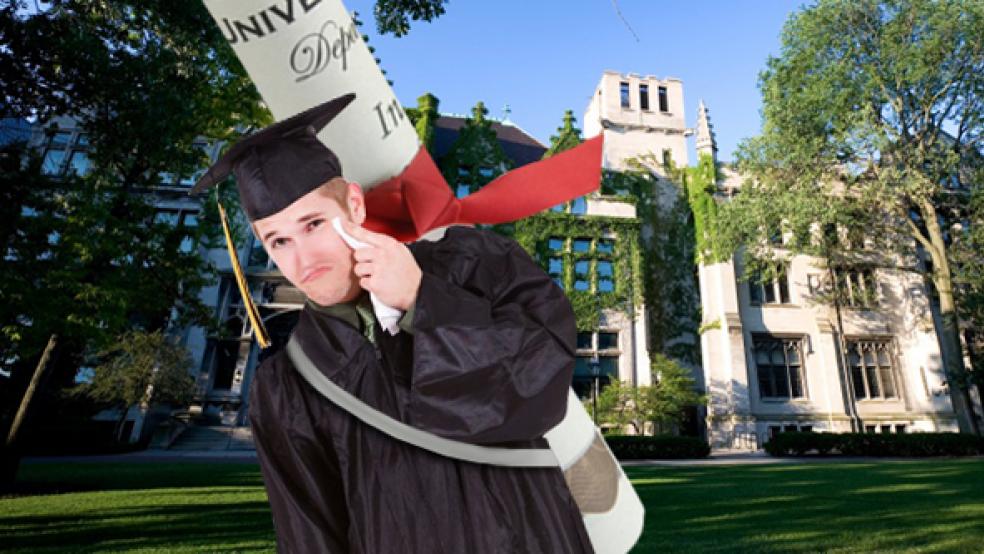Six months after receiving a Bachelor of Arts degree at the private digital arts college in California, 22-year-old Will Christiansen received his first student loan bill. The minimum monthly payment was $1,200. Making just $45,000 per year as a graphic designer at an advertising company in New York City — and taking home about $2,800 a month after taxes — he panicked. “There was no way I could make a $1,200 payment and still pay rent,” he says. “I would simply have to defer until I found a better job.”
Christiansen graduated with $107,000 in debt, and he’s part of a small, but growing group of students who graduate with extreme and unmanageable levels of debt — debt that could keep them in the red for the rest of their lives, and potentially be passed onto their children. It’s the new $100k club, and entrance doesn’t even require a college degree.
It’s well known that college costs have skyrocketed in recent years, growing at about twice the rate of inflation, and student debt shoots up every year, with the average undergraduate student leaving school with $24,000 IOUs in 2009. $100k club members are outliers, but they’re helping that average creep up. Students who have attended graduate school make up the bulk of $100k members. Thirty percent of law students expect to graduate with more than $120,000 in debt. The Association of American Veterinary Colleges reports new vets graduate with a median debt of $103,573, and according to Mark Kantrowitz, publisher of FinAid.org and Fastweb.com, doctors on average graduate with about a $156,000 debt load. Others put the average at over $200,000 for physicians. Case in point — a 41-year-old doctor started out with $250,000 in debt and deferred her payments so that her debt mushroomed to $555,000.
“All too often, the students will sign whatever
piece of paper in front of them and say, ‘oh I’ll figure out
how to pay it back after I graduate.’”
But Bachelor degree students are gaining entrance to the club as well. The Institute for College Access and Success calculates that about 0.5 percent of undergraduate students accumulate $100,000 in loans, though Kantrowitz believes that number is higher. “Every year things get worse and more students are graduating with excessive debt,” he says. “Every year college affordability goes down, and students have to borrow more. It’s like cooking a lobster. By the time you notice the water is boiling, you’re already cooked.”
Financial advisors recommend students avoid taking out loans that might exceed their starting salary, but the future is unpredictable, and many graduates find a very different job market than when they started school four years earlier. For example, although veterinary school grads had a median debt of over $100,000, the median earnings of vets was just $79,050 in 2008, according to the Bureau of Labor Statistics. Even if a $100k club member snagged the elusive $100,000 starting-salary job, it doesn’t mean they’re living comfortably and in a position to start saving for the future.
“Growing student debt has an impact on decisions like home ownership, family formation, retirement saving, education savings and entrepreneurship,” says Lauren Asher, president of the Institute for College Access and Success. “These are all things that matter not only to individuals but our society and our economy as a whole.”
How does one get to $100k as an undergraduate? It’s not through federal loans to attend a state school. The federal loan limit for dependent undergrads is $31,000 and $57,500 for independent students. After exceeding the limit, most students turn to private lenders, many of which don’t have caps on interest rates or fees, they’re not dischargeable in bankruptcy and may not even be discharged in death. Private loans represented about 25 percent of educational borrowing in 2008, but have declined since due to the Ensuring Continued Access to Student Loans Act that raised federal loan borrowing limits.
“I get calls every day from students who are in extreme financial difficulty,” says Kantrowitz. “Unfortunately about half of them have steered towards the private loans and they’re out of luck. There’s not much that can be done. All too often, the students will sign whatever piece of paper in front of them and say, oh I’ll figure out how to pay it back after I graduate.”
A $100k member would also have had to attended a private school and qualify for little to no financial aid. About 20 percent of students attend a non-profit private school and 7 percent attend a for-profit private university, which have received a lot of attention recently for racking up high student debt levels. “There is an element of choice here,” says Kantrowitz. “You could choose to go to an in-state public college and save a lot of money. But many families and students feel that they’re entitled to go to a $50,000 a year school. But just because you want to drive a Bentley doesn’t mean you can afford to drive a Bentley.”
Christiansen chose his private college, Cogswell Polytechnical, because it specialized in his chosen field of animation and says he couldn’t find a public school program of a similar caliber. It costs nearly $27,000 a year including room and board, and his parents were too well off to qualify for aid, though he says it was mainly from property ownership, and not available cash. He maxed out on his federal loans at $31,000, and took out $77,000 in private loans with four different loan providers, which all have separate interest rates and rules for deferment.
“Many families and students feel that
they’re entitled to go to a $50,000 a year school.
But just because you want to drive a Bentley
doesn’t mean you can afford to drive a Bentley.”
It’s only been in the last few years that the government has started to crack down on student loan lenders, requiring that private lenders disclose basic things like interest rates. In June, the Obama administration released regulations that will require college career programs, particularly at for-profit schools, to prove that at least 35 percent of former students are gainfully employed and repaying their loans, or risk losing access to Federal student aid. They’re also requiring that all colleges post an online net price calculator. In addition, Federal programs like Income-Based Repayment and Public Service Loan Forgiveness have cropped up to help students pay down Federal loans. But students like Christiansen, who graduated in 2006 with massive private loans, have few options to turn to.
Since graduating, Christiansen has jumped from contract job to contract job, averaging $65,000 a year. He had to file for unemployment in 2008 when his company went under, deferring his loans once again. The jobs in his field are highly competitive and although some professionals can make over six figures, starting salaries rarely do. “I always had in mind that after I graduated school I’d be able to make $80,000 a year, and everyone gave the impression that that would be the case.” Not once did someone sit down with him to crunch the numbers and explain the risks involved. “As an 18-year-old kid all I cared about was getting approved for the student loans,” he says. “The whole thing felt like free money.”
Students get little or no financial counseling when they enter college. And for students who do receive counseling after they’ve enrolled, rarely will the advisor tell them they simply can’t afford their current school. “Some students just don’t get it,” says Kantrowitz. “There’s nobody there to tell them you shouldn’t borrow that much. No one is saying you can’t afford this school; you have to go to a different school. They’ve heard that education debt is good debt. Well, too much a good thing can hurt you.”
After deferring his loans for nearly a year after graduation, and again when he was unemployed, the interest on Christiansen’s loans shot up over $10,000. Four years later, he’s now nearly back to the original amount of $107,000. “I don’t have any more deferments or forbearances allowed for the life of my loans, so if I ever hit hard times, I’d be completely screwed,” he says.
In January this year, Christiansen had a lucky break. He was hired as a contract animator making just over six figures, and for the first time has been able to increase his loan payments, put money into a savings account, and open a Roth IRA. “It’s never going to be super comfortable, but I actually have enough now to save money.”
Related Links:
A Graduate Degree in Debt (Forbes)
Student Debt: Heavier Burdens, Narrower Career Choices (The Fiscal Times)
The Dark Side of Student Debt (Kiplinger)





